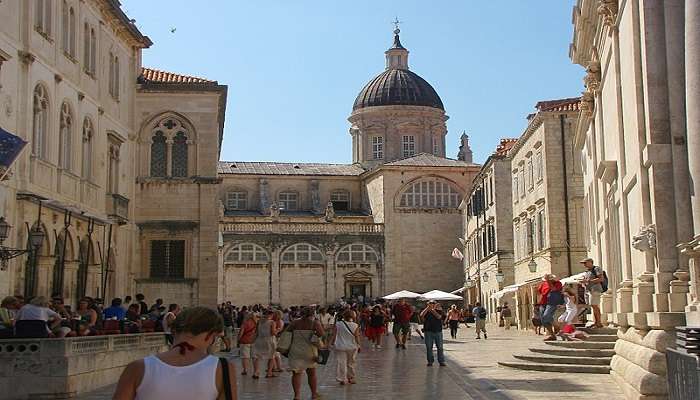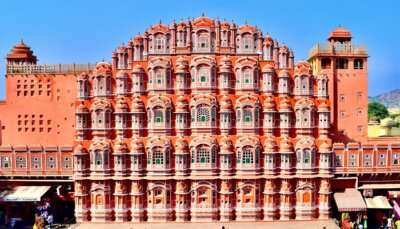Discover The Dubrovnik City Walls That Are Known For Their Grandeur

Perched majestically above the azure Adriatic Sea, the ancient Dubrovnik City Walls stand as a testament to medieval engineering and Croatia’s rich history. These formidable stone fortifications, which have guarded the “Pearl of the Adriatic” for centuries, offer visitors a unique glimpse into the past while providing breathtaking views of the terracotta rooftops and shimmering waters below. As you walk atop these UNESCO World Heritage-listed walls, you’ll trace the footsteps of countless defenders and feel the weight of history beneath your feet. Join us as we explore the secrets, stories, and stunning vistas of Dubrovnik’s iconic City Walls.
About Dubrovnik City Walls

Dubrovnik City Walls are a complex of stone walls that surround the old town of Dubrovnik, which is located in Croatia. They are listed by UNESCO as World Heritage sites. These walls are approximately 2km long and were constructed in the 7th to 17th century. It has many towers and fortresses.
As a protection against the enemies, the walls have been restored and maintained to this day as historical relics. Today, people can walk along the walls and enjoy the sea view and the views of the old architecture of the city. Not only can the tourists get to know more about the history of Dubrovnik, but they also have a chance to learn more about the culture and natural beauty of the region, which makes this place one of the most significant for tourists.
Also Read: Hvar Nightlife
History Of Dubrovnik City Walls

Dubrovnik City Walls are one of the finest examples of medieval fortification architecture and are believed to have been constructed in the early Middle Ages. The construction of the walls started in the 9th century with the siege of Dubrovnik by the Saracens, which lasted for 15 months. These walls enclosed the first nucleus of the inhabited area of the islet of Laus. In the 9th and 10th centuries, the eastern part of the city was enclosed by fortifications. In the 11th century, the narrow sea between the city and the mainland was filled with earthen, and by the 13th century, the whole city was surrounded by walls.
In the 14th century, the Dominican Monastery was incorporated into the walls, and 15 square forts were constructed to strengthen the city. The original construction of the walls can be traced back to the 14th century, but the final form was given after the fall of Constantinople in 1453, which is considered the ‘Golden Era’ of Dubrovnik. The walls were further strengthened and improved until the 16th century, as seen from the following: Today, the Dubrovnik City Walls, which are 2 km long and decorated with magnificent forts and gates, are the symbol of the city and powerful evidence of its historical value.
Entrances At Dubrovnik City Walls

Finding the entrances to the Dubrovnik City Walls is straightforward. The main entrance is right after you pass Pile Gate and reach Stradun main street. Most people use this entrance. However, there are two other entrances:
- After Pile Gate, on Stradun Street (marked No. 9 on the map)
- By the Ploče Gate, near St. Luke Fort (marked No. 23 on the map)
- By St. John’s Fortress, at the Maritime Museum (No. 20 on the map)
If the Old Town is crowded, especially during peak tourist season, you can bypass the main entrance and head straight to the port. There, you can climb to the top of the walls using the entrance at St. John’s Fort, which typically has less foot traffic and no lines.
Related Post: Krka National Park
Route To Explore

Start your walk at the Pile Gate, where you’ll see the drawbridge and people entering the Old Town. As you proceed along the western section, you’ll pass the Puncjela Tower and Bokar Fort, which guard the Pile Bay western harbour.
This section offers the best views of Fort Lovrijenac across Pile Bay. Moving to the southern seaside part, you’ll enjoy open views of the Adriatic Sea and Lokrum Island, passing six bastions and tiny watchtowers. Look down to spot sea kayaks and cliff jumpers at Buža bar. Continuing to the eastern section, you’ll reach St. John Fort and the Old Harbor, where you can watch ships and people promenading.
The route then takes you past Revelin Fort and Ploče Gate to the northern section, where you’ll walk past towers and bastions, climbing many steps towards Minčeta, the highest point in the Old Town. After touring Minčeta, descend back to the Pile Gate entrance to complete your walk.
The route includes 1080 steps, which can be slippery and narrow, making it less ideal for the elderly or young children due to the steep steps and lack of shade. Enjoy your walk around the Dubrovnik City Walls.
Things To Do

Dubrovnik’s City Walls offers a captivating mix of history, scenic views, and engaging activities. Below are some highlights you shouldn’t miss:
Catch the Sunset from Mount Srd: Mount Srd is the perfect spot to watch the sunset over Dubrovnik and the Adriatic Sea. You can reach the summit by cable car, hiking, or driving. The panoramic views are breathtaking, making it an ideal place to end your day.
Stroll Along the Ancient City Walls: Strolling along Dubrovnik’s medieval walls is a must-do. These walls stretch nearly 2 km and provide stunning views of the city and the sea. You’ll encounter several towers and fortresses, such as Fort Bokar and Minceta Tower, offering historical insights and great photo opportunities.
Discover Lokrum Island: A short boat ride from Dubrovnik, Lokrum Island is a nature reserve with lush vegetation, a botanical garden, and historical sites like the Benedictine Monastery. It’s also a popular spot for swimming and picnicking.
Relive Game of Thrones Moments: Dubrovnik was a filming location for King’s Landing in the Game of Thrones series. A walking tour will take you to iconic spots like the Pile Gate, Lovrijenac Fort, and the Jesuit Stairs, with guides sharing behind-the-scenes stories and showing you screenshots from the series.
Sip Drinks at a Cliffside Bar: Enjoy a refreshing drink at one of Dubrovnik’s cliff bars, such as Buza Bar. These bars are perched on the cliffs outside the city walls, offering stunning sea views and a relaxed atmosphere. It’s a great place to unwind and soak in the scenery.
Take a Dip from the City Walls: For a unique experience, take a dip in the Adriatic Sea directly from the city walls. Several spots offer access to the water, making it a refreshing break during your exploration of the walls.
Experience the Old Town by Night: Staying overnight in Dubrovnik’s Old Town allows you to experience its charm after the day-trippers have left. You’ll have the opportunity to explore the narrow streets, historic buildings, and local cafes at a more leisurely pace.
Related Post: Croatian Islands
Tickets Prices

When it comes to the Dubrovnik City Walls, it is more reasonable to get the Dubrovnik Pass that gives you access to 12 of the most popular attractions in Dubrovnik including the Rector’s Palace and the Ethnographic Museum. It also allows free access to the City Walls. There are three versions of the Dubrovnik Pass:
- A daily Pass (1 day) for €35
- A Three-Day Pass for €45
- ASeven-Day Pass for €55.
Since the City Walls tickets alone cost €35, the Dubrovnik Pass provides better value with additional benefits for the same price. Given Dubrovnik’s higher costs compared to neighbouring destinations, the Dubrovnik Pass is a budget-friendly option that can help you save money while exploring the city.
How To Reach?

Reaching the Dubrovnik City Walls is an essential part of exploring this historical gem. Below is a detailed guide on how to get there, along with key pointers for easy reference:
By Air
The nearest airport to Dubrovnik is Dubrovnik Airport (DBV), located about 20 km from the city centre. From the airport, you can take an airport shuttle bus that frequently runs between the airport and the city centre, with the journey taking around 30 minutes. Taxis are also available at the airport and can take you directly to the city centre in approximately 20-30 minutes.
By Train
Dubrovnik does not have a direct train connection. The nearest train station is in Ploče, about 100 km away. You can take a train to Ploče from major Croatian cities like Zagreb or Split. From Ploče, you can take a bus to Dubrovnik, with the bus journey taking around 2 hours.
By Bus
Dubrovnik is well-connected by intercity buses from various Croatian cities and neighbouring countries. The main bus station in Dubrovnik is located in Gruž, about 2.5 km from the Old Town. From the main bus station, you can take a local bus to Pile Gate, the western entrance to the Old Town. Buses run frequently, and the journey takes around 10 minutes.
You May Also Like To Read: Villas In Croatia
Dubrovnik City Walls stand as a testament to the city’s rich history and architectural prowess. As you walk along these ancient fortifications, you’ll be transported back in time while enjoying breathtaking views of the Adriatic Sea and the city’s terracotta rooftops. The walls offer a unique perspective on Dubrovnik’s past and present, making them an essential stop for any visitor. Ready to experience the magic of Dubrovnik and its iconic walls for yourself? Don’t miss out on the opportunity to explore this UNESCO World Heritage site and create unforgettable memories. Book your trip to Croatia today and prepare to be captivated by the charm of the Pearl of the Adriatic!
For our editorial codes of conduct and copyright disclaimer, please click here.
Cover Image Credit: Bernard Gagnon for Wikimedia Commons
Frequently Asked Questions About Dubrovnik City Walls
What are the walls of Dubrovnik fun facts?
The Dubrovnik city walls date back to the Middle Ages and stretch nearly 2 km around the Old Town. Remarkably, they have withstood various natural disasters, including the devastating 1667 earthquake, making them a symbol of resilience.
Are the city walls in Dubrovnik worth it?
Absolutely! Walking the city walls offers breathtaking views of the Adriatic Sea and Dubrovnik's historic architecture. The experience provides valuable historical insights, making it an essential part of exploring the city's rich heritage.
How long does it take to do the city walls in Dubrovnik?
Walking the entire length of Dubrovnik's city walls typically takes about 1.5 to 2 hours at a leisurely pace. This allows time to enjoy the panoramic views and explore the various towers and fortifications along the way.
Why do people stand on the wall in Dubrovnik?
People stand on the walls of Dubrovnik to soak in the stunning panoramic views of the city, the Adriatic Sea, and the surrounding landscape. It's also a way to connect with the historical significance of these ancient fortifications.
Are there toilets on the walls of Dubrovnik?
Yes, several restrooms are available along the route of the city walls. These facilities are conveniently located, ensuring that visitors can comfortably enjoy their walk without having to leave the walls.
People Also Read:
Things To Do In Croatia Shopping In Croatia Plitvice Lakes In Croatia

With a passion for exploring and travelling to the roads long forgotten, experience the world through enthralling stories and adventures. Join me as I share my experiences at some of the world’s most popular tourist destinations and quench that pestering curiosity with something exciting!











